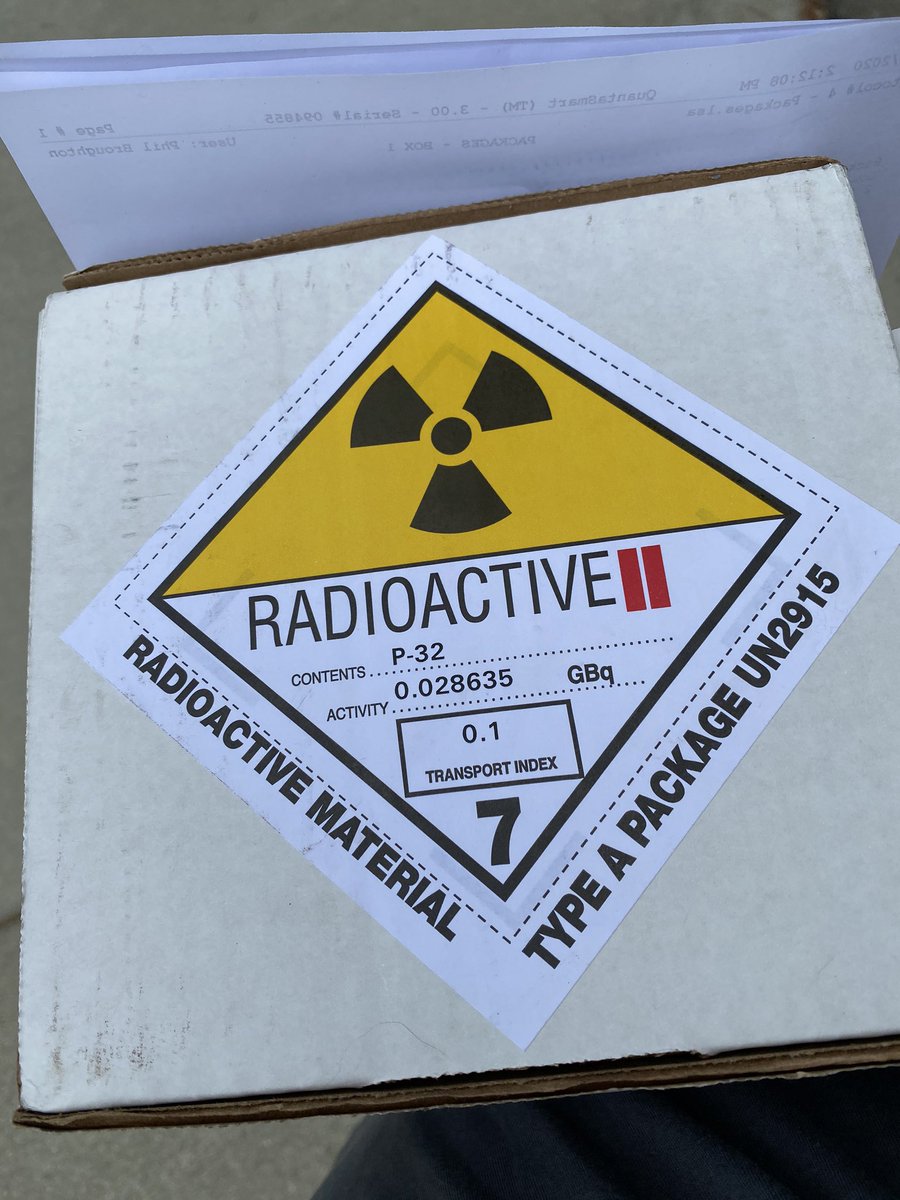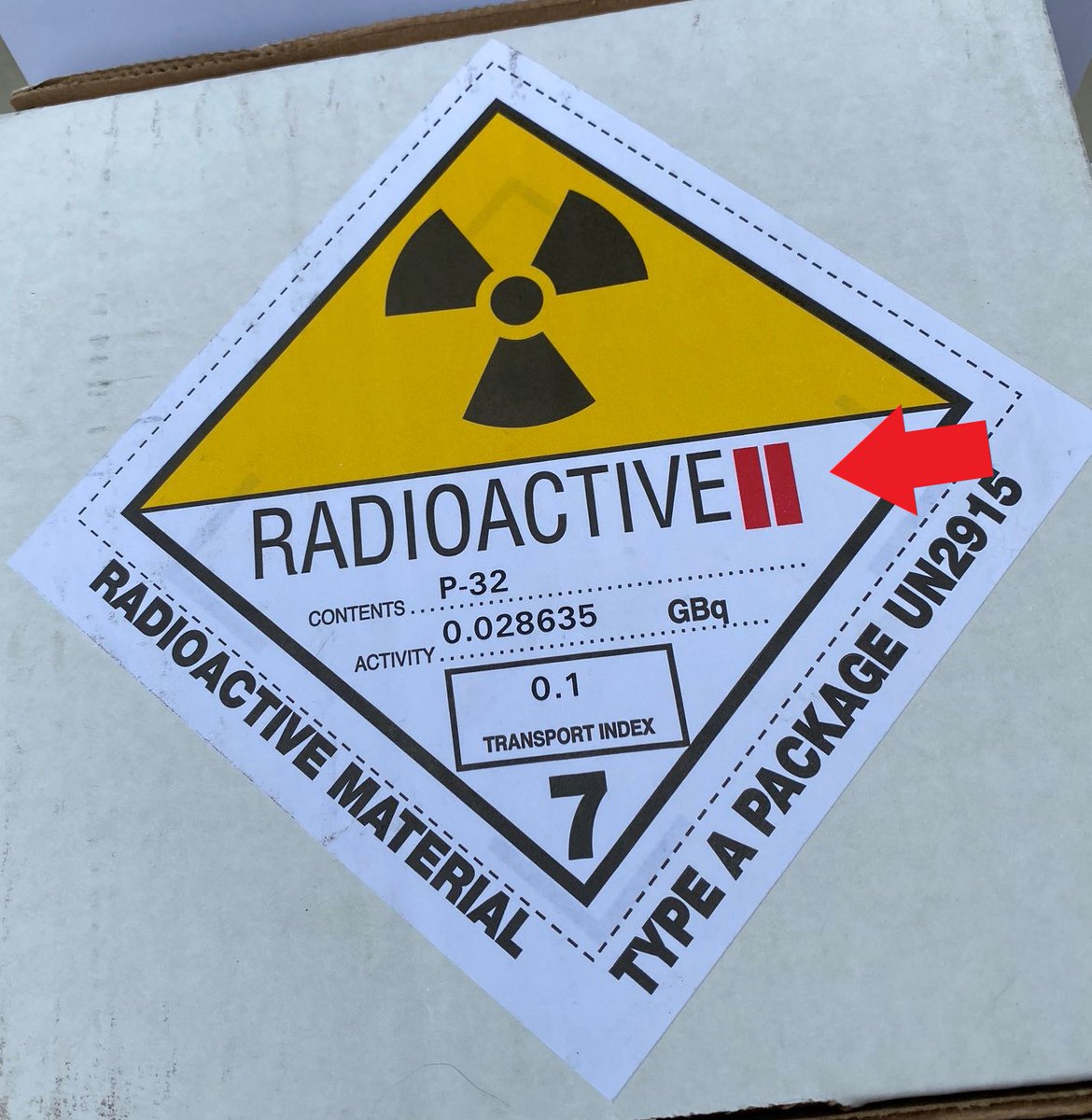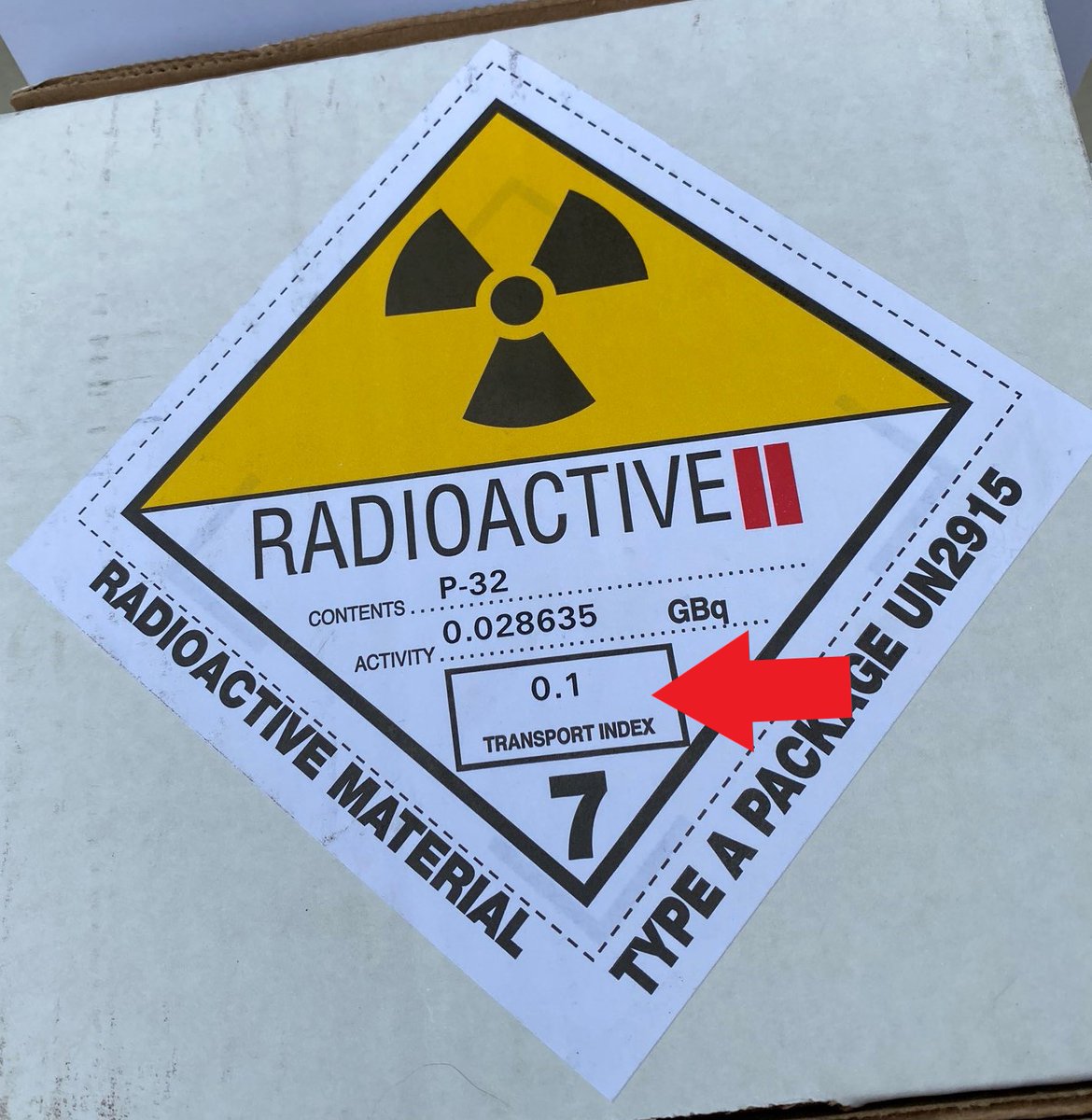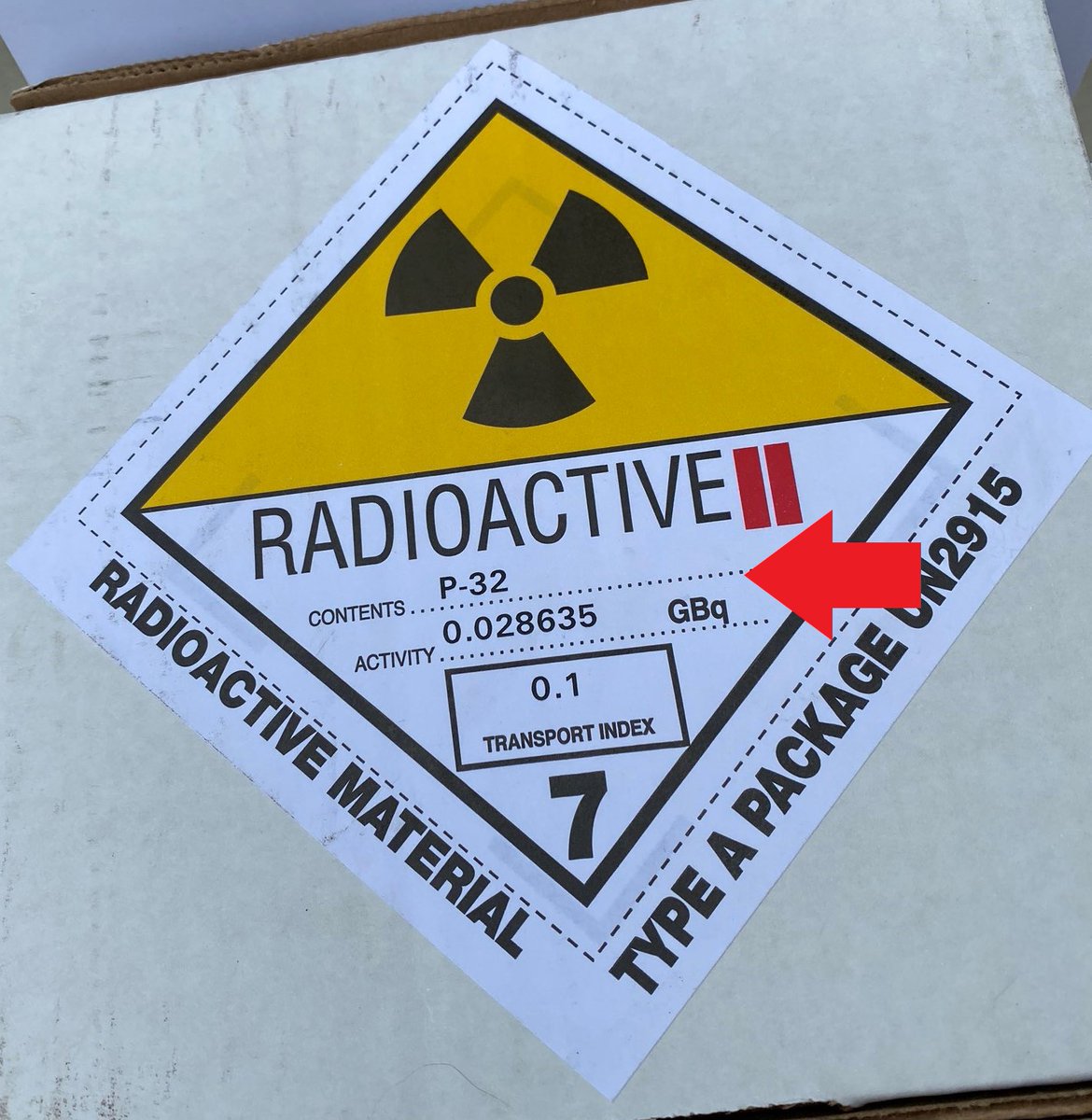One of the joys of carrying around a rad marked package is that everyone gives you plenty of social distance.
Since it appears that I need to say it for the smartass crowd:
DO NOT apply radioactive labels to things that aren’t radioactive.
There are activity limits for when you do & don’t use these labels. These are DOT regs which are rather stringently applied.
DO NOT apply radioactive labels to things that aren’t radioactive.
There are activity limits for when you do & don’t use these labels. These are DOT regs which are rather stringently applied.
I have been asked if I could please explain what this label in some detail.
[cracks knuckles] Okay, lets start with the number at the bottom. In the DOT hazardous materials communication system, 7 denotes materials where the PRIMARY hazard is radioactivity.
[cracks knuckles] Okay, lets start with the number at the bottom. In the DOT hazardous materials communication system, 7 denotes materials where the PRIMARY hazard is radioactivity.
The DOT labels/placards run from 1 to 9 where a lower number denotes a higher and more immediate hazard in the event of a *transport* accident. Accordingly, the 1's are explosives.
Now, while you might be frightened of radioactivity and contamination incidents are annoying difficult to clean up, they aren't THAT dangerous. Not compared to your tanker truck of gasoline (DOT 3 - Flammable Liquid) or the overturned Terminix truck (DOT 6 - Poison)
So, when you have a DOT 7 sticker or placard, you know that you have decent amount of activity and measurable dose rate. Which brings us to the next part of the label, RADIOACTIVE II.
We decided we needed to break radioactive materials shipments down into different flavors: Radioactive I, Radioactive II and, heaven forbid you ever see a vehicle with it, Radioactive III.
The flavors:
Rad I: contact dose rate < .005mSv/hr
Rad II: contact dose rate < .5mSv/hr AND <.01mSv/hr at 1m
Rad III: contact dose rate > .5mSv/hr OR <.01mSv/hr at 1m
I have only ever seen one vehicle with a Rad III on it and it was hauling interesting things
Rad I: contact dose rate < .005mSv/hr
Rad II: contact dose rate < .5mSv/hr AND <.01mSv/hr at 1m
Rad III: contact dose rate > .5mSv/hr OR <.01mSv/hr at 1m
I have only ever seen one vehicle with a Rad III on it and it was hauling interesting things
You are required to write on the label what that contact dose rate is. In the United States, you write it WITHOUT UNITS, in the Transport Index box expressed in the classic mrem/hr units. This is annoying to people who like and commonly think in SI units.
For example, Canadians.
For example, Canadians.
For packages, you do actually need to tell people what is inside the package, what the activity is, and holy fuck that better match what the manifest/waybill/bill of lading/airbill for the entire vehicle says when stopped for inspection.
Mispacked parcels happen. It can be bad.
Mispacked parcels happen. It can be bad.
So, this is just one box. What about the trucks you see with diamonds? If they have even a single box labelled like this, do they have to placard the entire truck?
The answer is the usual one everyone hates: It Depends.
The answer is the usual one everyone hates: It Depends.
You may have a Fedex truck absolutely loaded with Rad I parcels of all kinds of different isotopes. In aggregate, as long as their activity is "low enough" you don't have to placard the truck. This has lead to some nasty surprises for responders at highway accidents.
But if you have something S P I C Y, one package alone may cause the truck to be placarded. In fact, new rules start creeping in about what you can and cannot ship with it.
For example, you don't see DOT 1.1 and DOT 7 - Rad II together. That's known as a dirty bomb on wheels.
For example, you don't see DOT 1.1 and DOT 7 - Rad II together. That's known as a dirty bomb on wheels.
Ah, two more thing on that package. On the edge, they've politely added "TYPE A PACKAGE UN2915".
The UN Code is the international four digit designation to let anyone look up what material is in this package. 2915 means non-fissile, radioactive, type A package, not special form.
The UN Code is the international four digit designation to let anyone look up what material is in this package. 2915 means non-fissile, radioactive, type A package, not special form.
A Type A package is, basically, a box, drum, or bucket. More robust than normal perhaps, usually with a secondary container inside.
Type B? That's where you usually see Rad III. Here's a video of a Type B container being tested.
Type B? That's where you usually see Rad III. Here's a video of a Type B container being tested.
While a spent fuel cask is an extreme example of a Type B package, they are EXPENSIVE because of this testing. We do our best to not need those if we can help it. They get recycled, decon'd, and recertified over and over.
But back to posting your vehicle, when you need which kind of package, and what you can & cannot ship your package with, you* get to deal with DOT's A-1 and A-2 tables.
*: the shipping manager who eats, sleeps, and breathes DOT regs, hopefully
https://www.law.cornell.edu/cfr/text/49/173.435
*: the shipping manager who eats, sleeps, and breathes DOT regs, hopefully
https://www.law.cornell.edu/cfr/text/49/173.435
If you are shipping something very interesting indeed, your item may be the only thing permitted to on that vehicle. And you may not be allowed to drive just anywhere.
You may have to register your route for approval with DOT before you even load the vehicle.
You may have to register your route for approval with DOT before you even load the vehicle.
Now, as for when you use these labels and placards, the A-1 & A-2 tables and the dose rates tell you. A plutonium pit in it's container likely wouldn't need more than a Rad I label based ONLY on dose rate.
Which is why the tables are there to keep you from having an oops.
Which is why the tables are there to keep you from having an oops.
The short version is if you meet the table or dose rate requirements, you MUST use the correct label for shipping.
If you have radioactive material but it isn't peppy enough, congratulations, you have an Exempt Package. You get to use the boring UN 2910 marking with no trefoil.
If you have radioactive material but it isn't peppy enough, congratulations, you have an Exempt Package. You get to use the boring UN 2910 marking with no trefoil.
Now let's discuss what happens if you slap one of these labels on the trunk of your car for teh lulz.
For one, you are very likely to get pulled over. DOT employees will not be the ones talking to you. It will be your local highway patrol or state troopers.
For one, you are very likely to get pulled over. DOT employees will not be the ones talking to you. It will be your local highway patrol or state troopers.
Keep in mind, unlike you, they are constantly minding the freight haulers and know the DOT shipping rules well. They are going to ask for your shipping manifest.
You won't have one.
They'll ask why you have placarded vehicle and no manifest.
You have no good answer to this.
You won't have one.
They'll ask why you have placarded vehicle and no manifest.
You have no good answer to this.
On top of whatever state infractions they feel like hitting you with, DOT fines for screwing around with the hazmat fines are nasty on purpose to make sure the shippers toe the line.
Also, let us keep in mind that these are gunhavers. I hope fines are all you get rather than bullets.
~fin~
~fin~
Okay, one addendum. If you put your package in the basket of your bicycle, you may be required to placard the bike in addition to the label that's package.
Yes, it sounds dumb but a bike *is* a vehicle which makes the rules apply. So, walk it over.
[shakes angryfist at LLNL]
Yes, it sounds dumb but a bike *is* a vehicle which makes the rules apply. So, walk it over.
[shakes angryfist at LLNL]

 Read on Twitter
Read on Twitter
![I have been asked if I could please explain what this label in some detail. [cracks knuckles] Okay, lets start with the number at the bottom. In the DOT hazardous materials communication system, 7 denotes materials where the PRIMARY hazard is radioactivity. I have been asked if I could please explain what this label in some detail. [cracks knuckles] Okay, lets start with the number at the bottom. In the DOT hazardous materials communication system, 7 denotes materials where the PRIMARY hazard is radioactivity.](https://pbs.twimg.com/media/Efazn7PUEAAeGcn.jpg)





